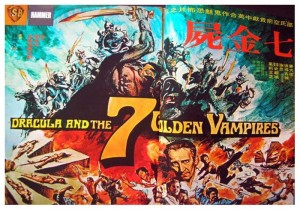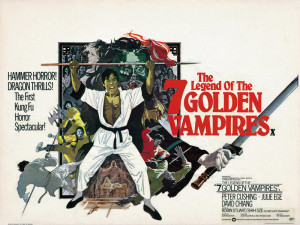The Legend of the 7 Golden Vampires
七金尸
UK/Hong Kong, 1974, colour, 2.35:1, 89 mins.
Director: Roy Ward Baker.
Rating: 3/10.
Dracula goes East in this laboured co-production between UK horror specialist Hammer and the Shaw Brothers studio.
Transylvania, Central Europe, 1804. Chinese vampire Kah (Zhan Sen) visits Count Dracula (John Forbes-Robertson) and asks him for help in keeping alive the cult of the 7 Golden Vampires in his home village of Pinggui, Sichuan province. Desperate to get out of his castle, Dracula agrees, taking over Kah’s body. Chongqing, 1904. Travelling with his son Leyland (Robin Stewart), well-known vampire  hunter Professor Lawrence van Helsing (Peter Cushing) is lecturing to students at the university, but they don’t believe him when he says China also has vampires. However, one student, Xu Qing (Jiang Dawei), does believe him, and asks for his help in exterminating the cult of the 7 Golden Vampires that controls his ancestral village, Pinggui, and led to the death of his grandfather (Jiang Dawei). A rich Scandinavian widow, Vanessa Buren (Julie Ege), who is travelling in China, agrees to fund Xu Qing’s expedition, and Professor van Helsing agrees to join it with his son. Also in the group are Xu Qing’s brothers and his sister Xu Meigui (Shi Si), all martial artists.
hunter Professor Lawrence van Helsing (Peter Cushing) is lecturing to students at the university, but they don’t believe him when he says China also has vampires. However, one student, Xu Qing (Jiang Dawei), does believe him, and asks for his help in exterminating the cult of the 7 Golden Vampires that controls his ancestral village, Pinggui, and led to the death of his grandfather (Jiang Dawei). A rich Scandinavian widow, Vanessa Buren (Julie Ege), who is travelling in China, agrees to fund Xu Qing’s expedition, and Professor van Helsing agrees to join it with his son. Also in the group are Xu Qing’s brothers and his sister Xu Meigui (Shi Si), all martial artists.
REVIEW
It seems fairly certain, given the natural pitfalls of such a situation, that Hong Kong [as of mid-1974] will never find a satisfactory “replacement” for the superstar Li Xiaolong 李小龙 [Bruce Lee]. There are, however, many performers who possess sufficient, if reduced, charisma to qualify in his absence. On the male side Jiang Dawei 姜大卫 [David Chiang] seems set to don the Li mantle, and as if to consolidate his position, he stars alongside Peter Cushing in the first Hammer Film-Shaw Brothers co-production. Refreshingly enough, the size of one’s stature or sexual equipment means little with martial arts superstars: Jiang has the same disquieting diminutiveness which can erupt into action at a moment’s notice, and his faint suggestion of a smile serves to garnish an underlying seriousness. His films have already [as of mid-1974] had wide circulation in Britain: The New One-Armed Swordsman 新独臂刀 (1971), Four Riders 四骑士 (1972) [released as Hellfighters of the East in the UK] and The Blood Brothers 刺马 (1973) [Chinese Vengeance in the UK]. There are plenty more in the pipeline.
When one comes to The Legend of the 7 Golden Vampires certain terms of reference have to be ironed out. Despite the mixture of martial arts and vampirism, [UK horror specialist] Hammer and Shaw, Chinese crew members and British technicians, the film emerges quite definitely as an Eastern Hammer rather than Hammer Eastern – that is to say, yet another Dracula variation (set in China) rather than a martial arts picture (with Western stars and vampirism). This difference is worth straightening out since [British writer-director] Don Houghton [who also wrote the second, and last, Hammer-Shaw co-production, Shatter 夺命刺客 (1974)] and his team have obviously gone to some lengths to try to absorb some of the Shaw atmosphere. Their failure results in a work with several good moments but which shows even more clearly the constipation that grips most Hammer productions nowadays. As such, the use of many good Shaw players seems little more than a condescension; one wishes the film had either been written and directed by the Chinese themselves or left to Hammer without the presence of Hong Kong stars.
The flimsy excuse for transferring vampire-hunter van Helsing to the East is given in a nicely-atmospheric prologue: Dracula (Transylvania 1804) assumes the appearance of a visiting Chinese vampire so as to assume leadership of the 7 Golden Vampires several thousand miles away. Cut to Chongqing 1904, where van Helsing is lecturing to a disbelieving audience; later he is approached by one of the Xu brothers (Jiang Dawei) who urges him to journey with them to their village of Pinggui to rid its people of the Golden Vampires’ tyranny. The rest of the story springs no surprises.
On the credit side the film has several points of recommendation. Filmed entirely in the Shaws’ own studio, its sets and art direction have a convincing familiarity. Much use is made of luridly coloured lighting, and the script often acknowledges the difficulties van Helsing faces in applying European methods when hunting Eastern vampires. “I am an outsider, I accept that!” he calls to sceptical departing students, and there are odd comments throughout the film which show van Helsing’s wonder at the philosophies and martial arts of Xu Qing and his brothers. It is good to see Chinese nationalism (so strongly stressed in their own films) survive intact. On the other hand, many of the film’s positive qualities are overwhelmed by director Roy Ward Baker and the Hammer team’s inflexible approach to their subject. This, in the end, is what makes it an Eastern Hammer rather than vice versa. The laborious plot filling, textbook establishing shots, lingering over special effects and soppy conventional love stories all serve to disperse any tension or excitement that threatens to break out. In short, Hammer have not made the slightest allowance to the cult they are exploiting, and as a consequence insult their co-producers. Shots of bare breasts look all the more incongruous and gratuitous in the Chinese setting, while the intrusion of realistically-tattered clothing and much-reduced sound effects in the combat sequences provide the final death-blow to any chances of the film possessing the mythic quality of genuine Hong Kong productions.
Peter Cushing at least does his best to give the film some shape, but amid the lack of that essential mythic atmosphere the Chinese actors are made to look rather stupid. Nevertheless, Jiang Dawei measures up well to Cushing, and between the two the film just about keeps moving. The attractive [Taiwan ballet student] Shi Si 施思 (adopting the short-sword style of combat used by Zheng Peipei 郑佩佩 in Golden Swallow 金燕子 [1968]) soon shows up the pointless presence of Julie Ege without uttering a word: this Norwegian “actress” would be better off exhibiting herself in some tawdry sex-comedy [for which she was well known at the time] instead of clogging up a film so desperately in need of support.
[In Hong Kong the film’s English title was Dracula and the 7 Golden Vampires. Shaw Brothers contract director Zhang Che 张彻 also worked, uncredited, on the film.]
CREDITS
Presented by Hammer Film Productions (UK), Shaw Brothers (HK). Produced by Hammer Film Productions (UK), Shaw Brothers (HK).
Script: Don Houghton. Photography: John Wilcox, Roy Ford. Editing: Chris Barnes. Music: James Bernard. Music supervision: Philip Martell. Art direction: Cao Zhuangsheng [Johnson Tsao]. Costumes: Liu Jiyou. Sound: Les Hammond. Action: Tang Jia, Liu Jialiang. Special effects: Les Bowie.
Cast: Peter Cushing (Professor Lawrence van Helsing), Jiang Dawei [David Chiang] (Xu Qing; Xu Tian’an, his grandfather), Julie Ege (Vanessa Buren), Robin Stewart (Leyland van Helsing), Shi Si (Xu Meigui), John Forbes-Robertson (Count Dracula), Robert Hanna (British trade consul in Chongqing), Zhan Sen (Kah), Ma Zhanshi (Xu Da, the axe fighter), Liu Huiling (Vanessa’s female friend), Liu Jiarong (Xu Gui, the archer), Wang Hanchen (Liang Han), Chen Tianlong (Xu San), Feng Ke’an (Xu Song).
Release: Hong Kong, 11 Jul 1974; UK, 6 Oct 1974.
(Review section originally published in UK monthly films and filming, Oct 1974. Modern annotations in square brackets.)
